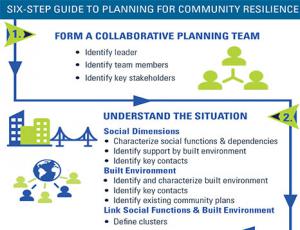Resilience Evaluating investments in community resilience
Communities weighing choices for capital improvement projects intended to improve their resilience to severe weather, wildfires, earthquakes, or other types of hazards now have a new guide to help them sort through the costs and benefits of each when deciding which investment is best for their particular circumstances. A new NIST report details steps for evaluating the “economic ramifications” of contemplated resilience investments as well as the option of maintaining the status quo.

NIST's guide to community resilience project selection and planning // Source: nist.gov
Communities weighing choices for capital improvement projects intended to improve their resilience to severe weather, wildfires, earthquakes, or other types of hazards now have a new guide to help them sort through the costs and benefits of each when deciding which investment is best for their particular circumstances. Prepared by National Institute of Standards and Technology (NIST) economists, the Community Resilience Economic Decision Guide for Buildings and Infrastructure Systems details steps for evaluating the “economic ramifications” of contemplated resilience investments as well as the option of maintaining the status quo.
NIST notes that the new publication complements NIST’s recently issued Community Resilience Planning Guide for Buildings and Infrastructure Systems. That guide lays out a practical six-step process that communities can follow to develop resilience plans that help them prepare for hazards, adapt to changing conditions and withstand and rapidly recover from disruptions. Community-developed resilience plans help governments, utilities, service providers and other organizations set priorities and allocate resources for mitigating damage, maintaining vital services, and if a hazard does strike, building back better.
The new economic guide helps communities to nail down critical elements of these proactive, long-term plans — the capital investments most likely to yield the greatest returns, the sum of net cost savings, damage avoided and secondary benefits reaped by the community. It provides the basis for comparing and contrasting alternate investments during development of the resilience plan, the fourth step in the process laid out in the planning guide.
In addition, the approach described by the NIST economists enables evaluation of prospective resilience investments in the broader context of other community goals such as economic development and emergency management. Identifying and including secondary “resilience dividends”—more reliable utility systems, for example — should help to “mainstream resilience into community decision-making and, ultimately, help to make communities less vulnerable to long-term disruptions that jeopardize their futures,” explains NIST economist David Butry. He notes that, in addition to overlapping benefits, some of these interacting effects also may impose secondary costs, which should be recognized early on as well.
Following the approach described by Butry, lead author Stanley Gilbert, and their colleagues, communities will establish planning horizons, constraints, risk tolerance (or aversion) and discount rates — or opportunity costs for investments forgone. The economic guide also details how to do an accounting of anticipated costs and benefits as well as noneconomic considerations such as environmental, social and cultural impacts that do not have a market-determined price tag.
The economic evaluation also reckons with the challenge of uncertainty posed by hazard events that are likely over a particular planning period — yet unpredictable in terms of their timing and severity. It describes several methods that communities can use to estimate future costs, losses and benefits in light of the uncertainty inherent in the process.
Yet, as the economic guide points out, “Experience shows that communities generally over-estimate their ability to successfully deal with hazard events … It may also be that communities either underestimate risk exposure or assume that meaningful improvements are cost prohibitive.”
The economic guide draws on input received during a NIST-organized workshop in April 2015. The more than seventy participants included planners, government executives, economists, engineers, experts in finance and risk analysis and other stakeholders. It is the latest output of NIST’s multifaceted Community Resilience Program, a strategic initiative that is developing new and innovative approaches to community resilience and underlying decision-making processes. For example, the NIST-funded Center for Risk-Based Community Resilience Planning, based at Colorado State University, is developing methods for evaluating how hazard-caused failures of infrastructure systems such as power and water can have cascading effects on communities, their residents, businesses and institutions.
You may download the Community Resilience Economic Decision Guide for Buildings and Infrastructure Systems here.
